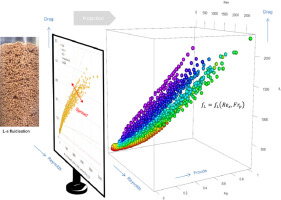当前位置:
X-MOL 学术
›
Int. J. Multiphase Flow
›
论文详情
Our official English website, www.x-mol.net, welcomes your feedback! (Note: you will need to create a separate account there.)
Improvement of voidage prediction in liquid-solid fluidized beds by inclusion of the Froude number in effective drag relations
International Journal of Multiphase Flow ( IF 3.8 ) Pub Date : 2020-06-01 , DOI: 10.1016/j.ijmultiphaseflow.2020.103261 O.J.I. Kramer , J.T. Padding , W.H. van Vugt , P.J. de Moel , E.T. Baars , E.S. Boek , J.P. van der Hoek
International Journal of Multiphase Flow ( IF 3.8 ) Pub Date : 2020-06-01 , DOI: 10.1016/j.ijmultiphaseflow.2020.103261 O.J.I. Kramer , J.T. Padding , W.H. van Vugt , P.J. de Moel , E.T. Baars , E.S. Boek , J.P. van der Hoek

|
Abstract A novel effective drag relation for liquid-solid fluidisation is proposed, suitable for application in full-scale installations. This is achieved by presenting new insights related to the influence of the temporal-spatial heterogeneity on the effective hydrodynamic drag for large fluidised systems. While heterogeneous flow behaviour can be predicted increasingly accurately in CFD simulations that explicitly model the heterogeneous solids distribution, for the operation of many large-scale applications it is infeasible to perform such computationally intensive simulations. Therefore, there is a clear need for full-scale drag relations that effectively take into account the heterogeneous behaviour and irregular spatial particle distributions. Our new drag relation is based on a large set of experiments, which shows that the degree of overall expansion is not only dependent on the ratio of laminar-turbulent flow, but also on the amount of homogenous versus heterogeneous flow, which is not included in current full-scale drag relations. To include the effect of heterogeneity, the standard drag relation, based on the Reynolds number, is extended with a specific type of Froude number. Because fully turbulent flow regimes are rare in applications of liquid-solid fluidisation, our focus is not on the turbulent flow regime but instead on laminar and transitional flow regimes. In these regimes, three types of models are investigated. The first type is based on a theoretical similarity with terminal settling, the second is based on the semi-empirical Carman-Kozeny model, and the third is based on empirical equations using symbolic regression techniques. For all three types of models, coefficients are calibrated on experimental data with monodisperse and almost spherical glass beads. The models are validated with a series of calcium carbonate grains applied in drinking water treatment processes as well as data obtained from the literature. Using these models, we show that the voidage prediction average relative error decreases from approximately 5% (according to the best literature equations which use Reynolds number only) to 1–2% (using both Reynolds and Froude number). This implies that our new models are more suitable for operational control in full-scale fluidised bed applications, such as pellet softening in drinking water treatment processes.
中文翻译:

通过在有效阻力关系中包含弗劳德数来改进液-固流化床中的空隙率预测
摘要 提出了一种用于液固流化的新型有效阻力关系,适用于全尺寸装置。这是通过提出与时空异质性对大型流化系统的有效流体动力阻力的影响相关的新见解来实现的。虽然在对非均质固体分布进行明确建模的 CFD 模拟中可以越来越准确地预测非均质流动行为,但对于许多大规模应用的操作而言,执行此类计算密集型模拟是不可行的。因此,显然需要有效考虑异质行为和不规则空间粒子分布的全尺寸阻力关系。我们新的阻力关系基于大量实验,这表明整体膨胀的程度不仅取决于层流-湍流的比率,还取决于均质流与非均质流的数量,这不包括在当前的全尺寸阻力关系中。为了包括异质性的影响,基于雷诺数的标准阻力关系扩展为特定类型的弗劳德数。由于完全湍流流态在液固流化应用中很少见,我们的重点不是湍流流态,而是层流和过渡流态。在这些制度中,研究了三种类型的模型。第一类基于与终端沉降的理论相似性,第二类基于半经验 Carman-Kozeny 模型,第三类基于使用符号回归技术的经验方程。对于所有三种类型的模型,系数都是根据使用单分散和几乎球形玻璃珠的实验数据校准的。这些模型通过一系列应用于饮用水处理过程的碳酸钙颗粒以及从文献中获得的数据进行了验证。使用这些模型,我们表明空隙率预测平均相对误差从大约 5%(根据仅使用雷诺数的最佳文献方程)降低到 1-2%(使用雷诺数和弗劳德数)。这意味着我们的新模型更适合全尺寸流化床应用中的操作控制,例如饮用水处理过程中的颗粒软化。这些模型通过一系列应用于饮用水处理过程的碳酸钙颗粒以及从文献中获得的数据进行了验证。使用这些模型,我们表明空隙率预测平均相对误差从大约 5%(根据仅使用雷诺数的最佳文献方程)降低到 1-2%(使用雷诺数和弗劳德数)。这意味着我们的新模型更适合全尺寸流化床应用中的操作控制,例如饮用水处理过程中的颗粒软化。这些模型通过一系列应用于饮用水处理过程的碳酸钙颗粒以及从文献中获得的数据进行了验证。使用这些模型,我们表明空隙率预测平均相对误差从大约 5%(根据仅使用雷诺数的最佳文献方程)降低到 1-2%(使用雷诺数和弗劳德数)。这意味着我们的新模型更适合全尺寸流化床应用中的操作控制,例如饮用水处理过程中的颗粒软化。我们表明空隙率预测平均相对误差从大约 5%(根据仅使用雷诺数的最佳文献方程)降低到 1-2%(使用雷诺数和弗劳德数)。这意味着我们的新模型更适合全尺寸流化床应用中的操作控制,例如饮用水处理过程中的颗粒软化。我们表明空隙率预测平均相对误差从大约 5%(根据仅使用雷诺数的最佳文献方程)降低到 1-2%(使用雷诺数和弗劳德数)。这意味着我们的新模型更适合全尺寸流化床应用中的操作控制,例如饮用水处理过程中的颗粒软化。
更新日期:2020-06-01
中文翻译:

通过在有效阻力关系中包含弗劳德数来改进液-固流化床中的空隙率预测
摘要 提出了一种用于液固流化的新型有效阻力关系,适用于全尺寸装置。这是通过提出与时空异质性对大型流化系统的有效流体动力阻力的影响相关的新见解来实现的。虽然在对非均质固体分布进行明确建模的 CFD 模拟中可以越来越准确地预测非均质流动行为,但对于许多大规模应用的操作而言,执行此类计算密集型模拟是不可行的。因此,显然需要有效考虑异质行为和不规则空间粒子分布的全尺寸阻力关系。我们新的阻力关系基于大量实验,这表明整体膨胀的程度不仅取决于层流-湍流的比率,还取决于均质流与非均质流的数量,这不包括在当前的全尺寸阻力关系中。为了包括异质性的影响,基于雷诺数的标准阻力关系扩展为特定类型的弗劳德数。由于完全湍流流态在液固流化应用中很少见,我们的重点不是湍流流态,而是层流和过渡流态。在这些制度中,研究了三种类型的模型。第一类基于与终端沉降的理论相似性,第二类基于半经验 Carman-Kozeny 模型,第三类基于使用符号回归技术的经验方程。对于所有三种类型的模型,系数都是根据使用单分散和几乎球形玻璃珠的实验数据校准的。这些模型通过一系列应用于饮用水处理过程的碳酸钙颗粒以及从文献中获得的数据进行了验证。使用这些模型,我们表明空隙率预测平均相对误差从大约 5%(根据仅使用雷诺数的最佳文献方程)降低到 1-2%(使用雷诺数和弗劳德数)。这意味着我们的新模型更适合全尺寸流化床应用中的操作控制,例如饮用水处理过程中的颗粒软化。这些模型通过一系列应用于饮用水处理过程的碳酸钙颗粒以及从文献中获得的数据进行了验证。使用这些模型,我们表明空隙率预测平均相对误差从大约 5%(根据仅使用雷诺数的最佳文献方程)降低到 1-2%(使用雷诺数和弗劳德数)。这意味着我们的新模型更适合全尺寸流化床应用中的操作控制,例如饮用水处理过程中的颗粒软化。这些模型通过一系列应用于饮用水处理过程的碳酸钙颗粒以及从文献中获得的数据进行了验证。使用这些模型,我们表明空隙率预测平均相对误差从大约 5%(根据仅使用雷诺数的最佳文献方程)降低到 1-2%(使用雷诺数和弗劳德数)。这意味着我们的新模型更适合全尺寸流化床应用中的操作控制,例如饮用水处理过程中的颗粒软化。我们表明空隙率预测平均相对误差从大约 5%(根据仅使用雷诺数的最佳文献方程)降低到 1-2%(使用雷诺数和弗劳德数)。这意味着我们的新模型更适合全尺寸流化床应用中的操作控制,例如饮用水处理过程中的颗粒软化。我们表明空隙率预测平均相对误差从大约 5%(根据仅使用雷诺数的最佳文献方程)降低到 1-2%(使用雷诺数和弗劳德数)。这意味着我们的新模型更适合全尺寸流化床应用中的操作控制,例如饮用水处理过程中的颗粒软化。


























 京公网安备 11010802027423号
京公网安备 11010802027423号